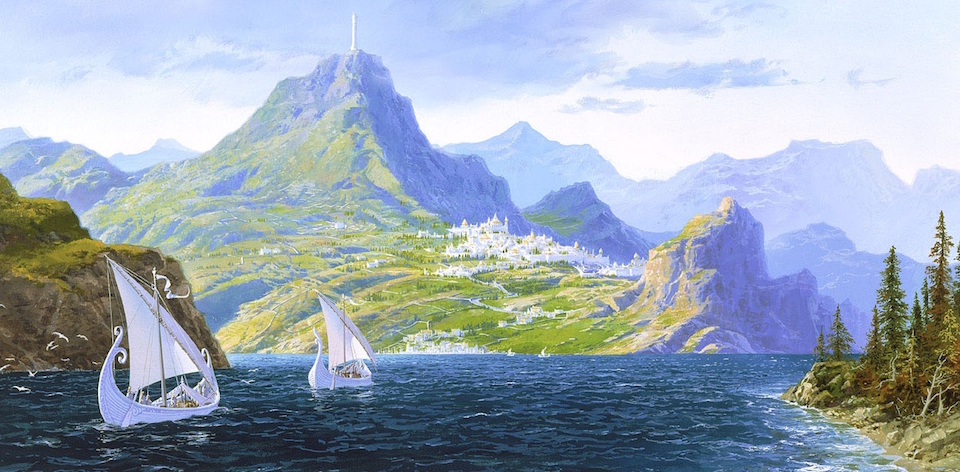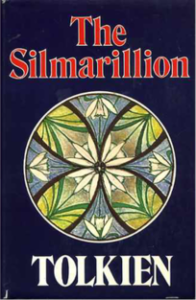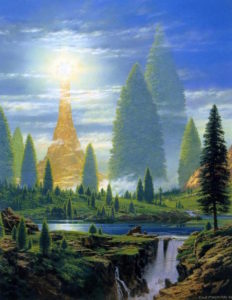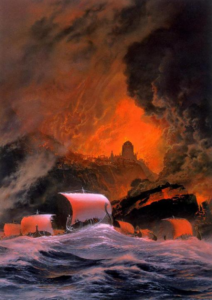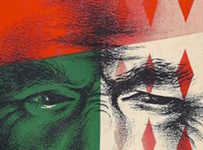Welcome to my new project The Read Goes Ever On: a structured reading (and in some cases re-reading) of the works of J.R.R. Tolkien.
As a casual fan who has read the ‘popular ones’ several times, this series is an attempt to explore Tolkien’s grand legendarium chronologically. Hundreds of scholars have already done deep reads, so this is just me trying to better understanding of Tolkien’s myths and legends by seeing them in context. Or to just point out cool stuff I liked along the way. Legendary spoilers abound.

Whether you have come to Tolkien through his books or via Peter Jackson’s film adaptations, The Hobbit and The Lord of the Rings are unquestionably Tolkien’s most accessible and popular works to date. THE SILMARILLION is infamous precisely because it is not, and it remains divisive among fans and critics alike. So, it is always with some trepidation that an initiate first cracks the spine of a virgin copy of the tome. Or in my case, loaded it up on a Kindle.
The version that we have today is, at its most basic level, an attempt to trace the history of Eä, the “world that is.” It is a creation story that takes place before and during the First Age, and the wars that began over the Silmarils: the gems from which the book derives its name. It explores the Second Age through myth and legend, including the Downfall of the island kingdom of Númenor, and the transition into the Third Age with the rise of Sauron’s evil, the creation of the Rings of Power, and the events that play out over the course of The Lord of the Rings.
First published in 1977, some four years after Tolkien’s death, the origins of the narrative can be traced back over sixty years earlier. Tolkien wrote his earliest versions of the stories in 1914, an attempt to create an English mythology that tied directly into contemporary history and culture. These early drafts eventually found their way into The Book of Lost Tales in 1984. Over the years, he drafted various versions, wrote epic poems, notes, and letters including a synopsis to R.W. Reynolds in 1926, and another to Milton Waldman in 1951.
While publishers universally rejected the idea, Tolkien felt that texts formed “the essential background to The Hobbit and its sequel.” It was an age-old creative impasse: Tolkien wanted THE SILMARILLION out as a companion to The Lord of the Rings, Allen & Unwin wanted the latter heavily edited. While the publisher eventually relented and published The Lord of the Rings in three parts, which history tells us worked out rather smashingly for them, Tolkien’s focus drifted away from THE SILMARILLION.
So, the book that we have in our hands is necessarily a stitch-job from Tolkien’s son Christopher, who has (sometimes controversially) taken on the mantle of compiling and restoring his father’s unfinished works. This is where the whole thing often comes unstuck for people. If someone finds the pieces of an object, especially one that was never completed in the first place, and then sticks it all back together again from less than ideal instructions, whose work is it?
The opening pieces, Ainulindalë and Valaquenta, are some of the most intriguing stories in what essentially amounts to a collection of short and often disconnected narratives. Like the Judeo-Christian Bible, it begins with a primary creation myth built around supreme being Ilúvatar showing the immortal Ainur a theme and bidding them to create music. It’s an elegant idea too, giving deeper roots to the songs that weave their way throughout Tolkien’s various works. In the beginning there were no words, but instead music.
Similarly, Biblical comparisons are peppered throughout. For example, in the chapter of the Quenta Silmarillion called “Of the Return of the Noldor,” Tolkien writes “and these folk are hewers of trees and hunters of water,” comparable to the Joshua 9:23 verse in which Joshua curses the Gibeonites. (Years later, Cormac McCarthy would similarly damn the forebears of The Kid in Blood Meridian, stating: “His folk are known for hewers of wood and drawers of water.”) Of course, Tolkien’s creationism is more Norse and Greek in its outlook, although it is difficult to draw a one-to-one comparison. Indeed, Tolkien has repeatedly dismissed such easy allusions.
Melkor emerges as a hell of an antagonist across the various stories, not only creating Sauron and the Balrogs in Valaquenta but continuously attempting to undo the works of the Valar (the higher Ainur) and disrupt the worlds of Elves and Men. Many of the tales that emerge with clear epic scope come from Melkor (later known as Morgoth) attempting to possess the powerful gems known as Silmarils; repeatedly attacking the Elves known as the Noldor; or turning the Elves and Men against each other through deceit. If there’s one constant across all of Tolkien’s writing, it’s that beings are easily swayed to darkness. Later, the tragedy of Túrin gives us a sense of the intergenerational curses of Morgoth – but still comes complete with the slaying of a dragon! (This story is told in greater detail in Children of Húrin).
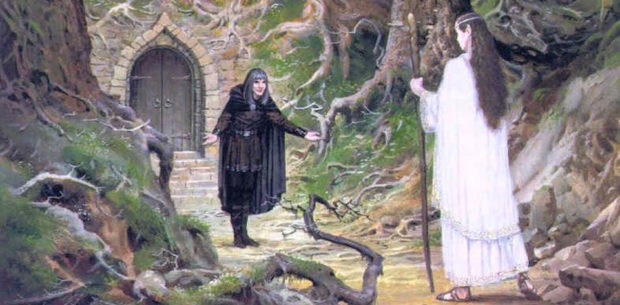
During all this darkness, a series of legendary stories emerge. Two tragic romances, for example, give some unlikely heart to proceedings. “Of Maeglin,” being the start of the saga of Eöl the Dark Elf and Aredhel, is one of the most classical pieces of the book so far. As writer Emmet O’Cuana comments, “Eöl is simultaneously the archetype for – and subversion of – every fantasy fiction antihero from Elric to Geralt.” Eöl uses enchantments to draw in Aredhel, after all, so there’s a dangling question as to whether this relationship constitutes an assault. (“Not wholly unwilling” is the phrase Tolkien uses, which doesn’t make it any less icky). Yet by the end of the saga, Eöl makes a choice that both dooms and ennobles him to a certain extent. Whether you view it as an act of heroic sacrifice or cowardice depends on where you personally sit.
The other great romance, of course, is that of “Beren and Lúthien.” The first of several unions of man and elf across the legendarium, it has direct ties to The Tale of Aragorn and Arwen, which is told in the appendices of The Lord of the Rings. While Christopher Tolkien would later compile the evolution of this story in a single volume, showing its various reworkings, the last complete version of is written for THE SILMARILLION. It begins with a reminder that “amid weeping there is joy and under the shadow of death light that endures.” Structured as a classic quest – its most fundamental pieces are ‘rescue the jewels, win the girl’ – it is a story that clearly had a lot of meaning for Tolkien. Not only was his wife Edith Bratt and inspiration for the “most beautiful of all the Children of Ilùvatar,” but the names Beren and Lúthien adorn Tolkien and Bratt’s headstone at Wolvercote Cemetery in Oxford.
Every great saga needs an ending, and the penultimate section Akallabêth is Tolkien’s first great dramatic conclusion. Or his last, depending on your point of view. Recounting the destruction of the Kingdom of Númenor, largely in part thanks to the machinations of Sauron, Tolkien’s spin on the Atlantean legend also sees Ilúvatar sink Númenor into the Sea as he breaks and remakes the world into a sphere. (Much has been made about the name Atalantë, which in Tolkien’s fictional language Quenya means “Downfallen,” and does sound remarkably close to ‘Atlantis.’ Tolkien dismisses this as a coincidence). Even the epic majesty of The Lord of the Rings can scarcely compete with the making, undoing, and rebuilding of the world.
Despite the calibre and scale of the myths woven between its covers, THE SILMARILLION remains an intensely difficult read. Called everything from “pompous” to “an incontestable masterwork of fantasy,” there’s a massive barrier to entry in the archaic language that Tolkien uses. The history and evolution of language is a massively important element in Tolkien’s creative and scholarly process, such as the Welsh influence on the Elvish language Sindarin. These stories are written in a way that make it impossible to read at a pace. New names and places are thrown at us virtually every paragraph, and it is difficult to keep track without an active Wiki session going while you’re reading. It doesn’t help that many of the names of characters change, or are used interchangeably with Elvish or Dwarven translations, for example. Regardless of your feelings towards the tales themselves, this is a slog.
In the context of The Hobbit and The Lord of the Rings, this collection called THE SILMARILLION really is the start of “one long Saga of the Jewels and the Rings” as Tolkien wrote to Waldman in 1951. In fact, the final story of the book – which is a far more approachable piece simply titled “Of the Rings of Power and the Third Age” – is pretty much a straight retelling of The Lord of the Rings. Assisted by Guy Gavriel Kay, Christopher Tolkien pulls together stories concerning the rise of Sauron following Isildur taking the One Ring into the Third Age. There’s some very cool stuff here, not least of which is the coming of Saruman, Radagast, Gandalf, and the Blue Wizards. (By the way, Gandalf & the Blue Wizards is a great name for a late-night lounge act). Thus, concludes Tolkien, “an end had come to the Eldar, of story and of song.” Which is not really a way I had looked at the extended ending of The Return of the King before. As Tolkien always intended, it was a conclusion to the song cycle that begun in Ainulindalë.
In the end, THE SILMARILLION isn’t quite as impenetrable as its reputation would suggest, but it is far from being an easy introduction to Tolkien. While it chronologically falls before The Hobbit and The Lord of the Rings, I only attempted it after multiple reads of those two stories. As such, it provides a healthy background for the next read-through and makes one fully realise that Tolkien’s legendarium is a rich tapestry of tales. It also doesn’t hurt that Amazon looks like they will be adapting some of this for their forthcoming Prime series.
In the next instalment of The Read Goes Ever On, I’ll jump forward thirty years to look at The Children of Hurin. An expansion of the version we see in The Silmarillion, the divisive 2007 compilation book is another case where Christopher Tolkien edited together manuscripts to form a complete narrative.

